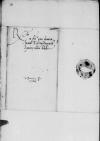Letter #2968
Sigismund II Augustus Jagiellon to Ioannes DANTISCUSVilnius, 1546-05-20
| received Heilsberg (Lidzbark Warmiński), 1546-06-05 Manuscript sources:
Prints:
| ||||||||||
Text & apparatus & commentaryPlain textText & commentaryText & apparatus
Reverendo in Christo Patri, domino
Reverende in Christo Pater sincere nobis dilecte.
Simula ms. al(!)
⌈lala ms. al(!)
⌉tque venisset ad nos illustr(issimus) or illustr(is)⌈illustr(issimus)illustr(issimus) or illustr(is)⌉
dominus
Et bene valeat.
Dat(um) or Dat(ae)⌈Dat(um)Dat(um) or Dat(ae)⌉
Ex commissione s(erenissimae) or s(acrae)⌈s(erenissimae)s(erenissimae) or s(acrae)⌉ maiestatis regiae propria


 Bcz, 1618, p. 82 (36)
Bcz, 1618, p. 82 (36)